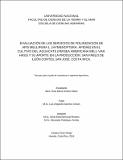| dc.contributor.author | Jiménez Masís, Rosa María | |
| dc.date.accessioned | 2017-02-09T17:20:59Z | |
| dc.date.available | 2017-02-09T17:20:59Z | |
| dc.date.created | 2017-02-09 | |
| dc.date.issued | 2016 | |
| dc.identifier.citation | | |
| dc.identifier.uri | http://hdl.handle.net/11056/13486 | |
| dc.description.abstract | Esta investigación se realizó en San Pablo de León Cortés, en la finca perteneciente
a la cooperativa APACOOP. Se evaluó el efecto de las visitas de Apis mellifera introducida
mediante colmenas, en la producción del cultivo de aguacate variedad Hass. Se seleccionaron
diez árboles al azar y en cada uno de ellos se marcaron dos ramas; una rama para valorar el
comportamiento de la polinización abierta durante la floración en estación seca y la otra rama,
utilizada posteriormente en estación lluviosa, para evaluar el número de visitas, preferencias
de recursos florales recolectados por la abeja melífera en las flores de aguacate; así como el
cuaje, número y peso de frutos. Las últimas tres variables mencionadas anteriormente,
también fueron valoradas en el ensayo de polinización abierta, durante la estación seca.
Asimismo, se eligieron seis árboles más y en cada uno de ellos una rama, las cuales se
aislaron de todo tipo de polinizador con el fin de evaluar la autopolinización. Se realizó un
muestreo de visitantes florales silvestres del cultivo que pudiesen tener un importante papel
ecosistémico en los servicios de polinización natural. Los principales visitantes florales
fueron los dípteros de las familias Sarcophagidae y Tachinidae; los himenópteros Agelaia
areata, abejas meliponinas de varias especies y Apis mellifera y coleópteros de la familia
Mordellidae. La abeja melífera destinó 97% y 3% de sus visitas a la recolecta de néctar y
néctar+polen respectivamente. No se observaron abejas recolectando exclusivamente polen.
El mayor número de visitas a las flores se presentó entre las 15:00-16:00 h, con un promedio
de 0.41/individuos/rama/min. El cuaje inicial, en estación seca, para polinización abierta fue
de 0.40%, mientras que en estación lluviosa, este fue de 1.47% cuando se introdujeron abejas
melíferas y de 0.12% en las ramas testigo, es decir, el cuaje con abejas melíferas fue doce
veces mayor que la autopolinización. El cuaje final en polinización abierta fue de 0.13% y
los frutos alcanzaron un peso promedio de 15 g; para los testigos el cuaje final fue muy bajo,
de 0.01% y no se obtuvieron valores de peso significativos; con la polinización por abejas
melíferas, el cuaje final fue de 0.04% y se percibió un incremento en el peso de los frutos,
los cuales alcanzaron 181 g/unidad en promedio, que implica un resultado promisorio del
papel de A. mellifera en la producción del cultivo, si se compara con los testigos. | es_ES |
| dc.description.abstract | This research was conducted in San Pablo de León Cortés in a farm belongs to the
APACOOP cooperative. A study was conducted on the effect of visits of introduced Apis
mellifera beehives in a crop production plantation of the Hass avocado variety. Ten trees
were randomly selected and on each one of them two branches were marked. One branch
was to evaluate the behavior of open pollination on flowers during the dry season. The other
branch was later used in the rainy season to evaluate the number of visits and the preferences
of floral resources collected by honey bees; as well as the fruit set, quantity and weight of the
harvested fruits. The last three variables previously mentioned were also evaluated during
open pollination in the dry season. In addition, six more trees were chosen and on each one
of them one branch was isolated from all types of pollinators in order to evaluate the selfpollination. Registering wild insect visitors conducted an evaluation about the value of
ecosystem services in the natural pollination of the crop. The main floral visitors were Diptera
with two families Sarcophagidae and Tachinidae, and the Hymenoptera wasp Agelaia areata,
Meliponine bees of several species and Apis mellifera, also members of Coleoptera,
Mordellidae family. Respect to the preferences of honey bees they collected 97% of nectar
and 3% of nectar and pollen. No bees were observed exclusively collecting pollen. The
greatest number of visits to the flowers occurred between 15:00-16:00 hrs, with an average
of 0.41/ individuals/ branch /min. The initial fruit set, in dry season, during open pollination
was 0.40%; meanwhile in rainy season, it was 1.47% when honey bees were introduced and
0.12% in control branches; therefore, fruit set with the honey bees were twelve times greater
than the self-pollination. The final fruit set in open pollination was 0.13% and the fruits
reached an average weight of 15 g; according to controls the final fruit set was very low with
0.01% and no significant weight values were obtained. The pollination by honey bees had a
final fruit set of 0.04% resulting in an increase of the fruit weight, which they reached 181 g/
average unit. This implicates a promising result of the role of Apis mellifera in crop
production of avocado in comparison to controls. | |
| dc.language.iso | es | es_ES |
| dc.publisher | Universidad Nacional (Costa Rica). Escuela de Ciencias Agrarias | es_ES |
| dc.rights | Acceso abierto | |
| dc.rights.uri | http://creativecommons.org/licenses/by-nc-nd/4.0/ | |
| dc.subject | POLINIZACIÓN | es_ES |
| dc.subject | AGUACATE | es_ES |
| dc.subject | APIS MELLIFERA | es_ES |
| dc.subject | HYMENOPTERA | es_ES |
| dc.subject | PERSEA AMERICANA | es_ES |
| dc.subject | FLORES | es_ES |
| dc.title | Evaluación de los servicios de polinización de Apis Mellifera L. (Hymenoptera: Apidae) en el cultivo del aguacate (Persea Americana Mill Var. Hass) y su aporte en la producción. San Pablo de León Cortés, San José, Costa Rica | es_ES |
| dc.type | http://purl.org/coar/resource_type/c_7a1f | es_ES |
| bk-old-una.tipo | Licenciatura en Ingeniería Agronómica | es_ES |
| una.tesis.numero | Tesis 9292 | es_ES |


